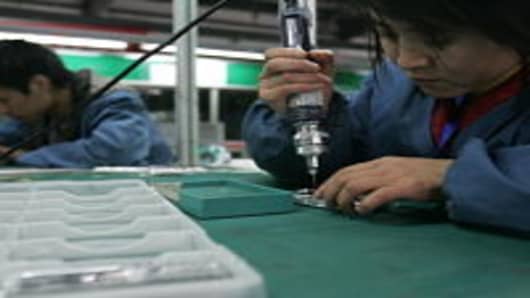Markets may be taking the latest manufacturing data from China positively, but one economist warns that the data point to further weakness in the economy, which could prompt authorities cut interest rates despite signs of inflation creeping higher.
The official Purchasing Managers' Index (PMI) that highlights large factories jumped to an 11-month high of 53.1 in March, up from February's reading of 51. The figure reinforces views that China is not sliding towards a hard landing, prompting risk to return to markets. The Australian dollar advanced 0.8 percent to $1.0428, while the MSCI Asia Pacific increased 0.4 percent in Tokyo in early morning trading.
But Nomura's Chief China Economist Zhiwei Zhang cautions that the actual underlying story "may not be that strong."
"Keep in mind that, in March, the official PMI always rises 3 percentage points from its February level. It's a seasonal factor," Zhang told CNBC Monday. "Compared to the past, the official average PMI is about 56, whereas this month, it's only 53. It's still very much lower."
A separate private survey of smaller factories by HSBC released on Sunday also showed factory activity in China slowing further. The HSBC PMI, fell to 48.3 in March from February's 49.6, largely in line with a preliminary PMI reading of 48.1 released in March.
This brought the measure into its worst quarter in three years between January and March, HSBC said in a statement, describing the rate of contraction in manufacturing output as the "steepest since November last year".
Nomura's Zhang says a lot of the country's small and medium companies are facing not only financing difficulties because of tightening credit in China but also "pretty weak" demand for their products.
He sees a cut in the benchmark lending rate as soon as this month because the PMI numbers indicate that demand is "really weakening".
"We believe that the government needs to cut the benchmark lending rate not just the triple-R (required reserve ratio) because the problem now is that demand is very weak," Zhang said. "The triple-R cuts also help to increase the supply of loans to the market but the problem now is really weakening demand so the government really needs to work on that."
Richard Jerram, Chief Economist of Bank of Singapore, points to the government’s strong fiscal position, which gives authorities plenty of room to stimulate the economy if there were signs that the economy is slowing at a quicker pace than expected.
"You can cut reserve requirements as much as you want I think," Jerram told CNBC Monday. "They've got a really good fiscal situation. They could expand some of the fiscal expenditure works as well."
The People’s Bank of China has reduced the RRR twice since November, by 50 basis points each time, in a bid to boost economic growth.
But the central bank will have to keep a close watch on rising prices if it takes on further monetary easing. Zhang pointed to inflation as a potential threat to the Chinese economy, after the sub-index for raw material purchasing prices rose for four consecutive months to 55.9 percent, 1.9 percentage points higher than a month ago.
"This inflation will affect the producers' price index and this will hurt profit margins of manufacturers and will hurt small, medium size enterprises more," Zhang said. "Going forward, this will be another pressure that will hurt manufacturing firms."


